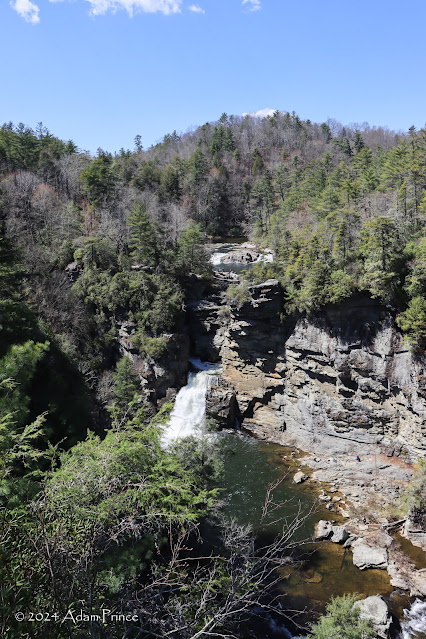Linville Falls is the dramatic start to the Linville Gorge - a 13-mile and 1,500- to 2,000-foot-deep natural wonder in North Carolina's mountains.
The Spur Road leads to a parking area for the falls with numerous hiking trails. There is a visitor's center that is open seasonally.
 |
| Map of the Linville Falls Area and hiking trails. (National Park Service) |
Two main trails provide access to the falls. The Linville Gorge Trail (1.4 miles round trip) follows the east side of the river and leads to the base of the falls and the Plunge Basin Overlook. The Erwin's View Trail (1.6 miles round trip) runs along the west side, leading to four different viewpoints - the Upper Falls, Chimney View, Gorge View, and Erwin's View. The Linville Gorge Trail is the more strenuous of the two.
On this visit, I explored the Erwins View Trail.
Upper Falls:
The first and typically most crowded viewpoint is of the twin 12-foot Upper Falls and the chute that the Linville River flows through before its more dramatic lower falls.
Chimney View:
It is a little over 1/4 mile from the Upper Falls to Chimney View. This location affords opportunities to view and photograph the lower falls in isolation.
Gorge View:
From Chimney View - an uphill climb leads you to two different vantage points. The furthest - via the right fork - is Gorge View. While this vantage point does not showcase Linville Falls, it presents a great view of Linville Gorge and spectacular birdwatching.
Erwins View:
Take the Left Fork near the end of the trail - and it leads to one of the most spectacular waterfall viewpoints in the Carolinas, Erwins View. From here, the entire landscape unfolds before you - the falls, the beginnings of Linville Gorge, the surrounding mountains, and more.
Dugger's Creek Falls:
When at the Linville Falls Parking Area - don't forget the short and easy trek to Dugger's Creek Falls, which sits near the entrance of the main parking lot. The loop trail is approximately 1/4-mile long and showcases a small 15' waterfall along Dugger's Creek.
Riverbend Overlook:
There are two Parkway overlooks on the Spur Road, Riverbend and Midway. The Riverbend Overlook sits along a horseshoe bend of the Linville River, a popular spot for fishing or picnicking.
Sources & Links:
- Linville Falls Hiking Trails ---National Park Service
- Linville Falls - Erwin's View Hike ---HikeWNC.info
- Duggers Creek Falls ---NCWaterfalls.com
- North Carolina Waterfalls - Where to Find Them, How to Photograph Them ---Kevin Adams
How To Get There:










Comments